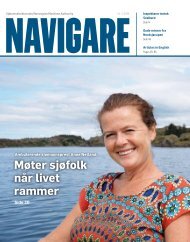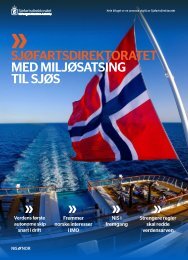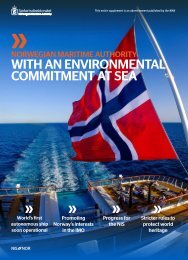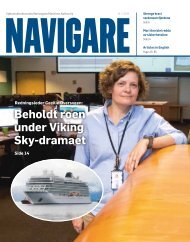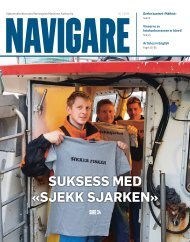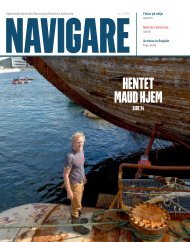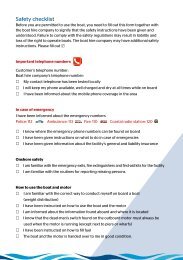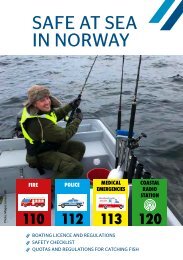Create successful ePaper yourself
Turn your PDF publications into a flip-book with our unique Google optimized e-Paper software.
NEWS<br />
ENGLISH TRANSLATION FROM PAGE 20<br />
Proposes stricter environmental<br />
requirements in the world heritage fjords<br />
KARI STAUTLAND, NMA<br />
New legislation intended to reduce emissions<br />
and discharges in the world heritage<br />
fjords was circulated for review this spring.<br />
In order to further reduce the environmental<br />
strain in the world heritage fjords, the<br />
Norwegian Maritime Authority (NMA) now<br />
proposes even stricter regulations. The<br />
proposed amendments will be circulated for<br />
review today, with a six week deadline for<br />
comments.<br />
In June this year, the NMA circulated<br />
for review new legislation for reduced<br />
emissions and discharges and a cleaner<br />
environment in the Nærøyfjord, Aurlandsfjord,<br />
Geirangerfjord, Sunnylvsfjord and<br />
Tafjord. The proposal included, among<br />
other things, stricter sulphur requirements<br />
for the entire area, stricter requirements for<br />
NOx emissions, prohibition against the<br />
discharge of sewage, regulations on the use<br />
of exhaust gas cleaning systems and requirement<br />
for an environmental instruction.<br />
Based on the comments received, the<br />
NMA is now proposing even stricter<br />
requirements in the new legislation.<br />
“The Government wishes to reduce the<br />
emissions and discharges from cruise ships.<br />
Stricter requirements for ships in the world<br />
heritage fjords would be a step in the right<br />
direction,” says Minister of Climate and<br />
Environment, Ola Elvestuen.<br />
The NMA is now proposing that fuel<br />
being used on ships in the world heritage<br />
fjords must have a sulphur content of<br />
maximum 0.10% by weight. Additionally, a<br />
prohibition against the use of exhaust gas<br />
cleaning systems in these areas is being<br />
proposed, including both open, closed and<br />
hybrid systems.<br />
Reduced emissions and discharges<br />
In practice, this means that the use of heavy<br />
fuel oil in the world heritage fjords will be<br />
banned, and that ships that currently use<br />
heavy fuel oil combined with an exhaust gas<br />
cleaning system will have to use marine<br />
PHOTO: NMA<br />
diesel instead when sailing in the world<br />
heritage fjords.<br />
“Experience shows that today’s cleaning<br />
systems emit visible smoke emissions, and<br />
some systems also generate discharges to<br />
sea. Even if the visible smoke is partly water<br />
vapour, it has a negative impact on people’s<br />
experiences of our world heritage fjords,”<br />
says Bjørn Pedersen, who is Head of<br />
Department of Legislation and International<br />
Relations in the NMA.<br />
The NMA is also proposing a prohibition<br />
against incineration of waste on board<br />
ships in the world heritage fjords, which will<br />
contribute to reducing the visible smoke<br />
emissions.<br />
“We have a particular responsibility for<br />
taking care of the fjords inscribed on<br />
UNESCO›s World Heritage List,” says<br />
Pedersen. The new proposal also lays down<br />
the possibility of exemption from the Tier I<br />
NOx requirements to be met by 2020 for<br />
ships that can document that they will<br />
satisfy the strictest NOx requirements<br />
(Tier III) by 2022, i.e. three years before<br />
the deadline.<br />
The Geirangerfjord is among the<br />
Norwegian fjords on the World Heritage<br />
List. It is a very popular destination for<br />
cruise tourists.<br />
64 | <strong>Navigare</strong> 4 - <strong>2018</strong>










